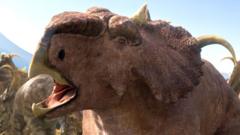Deep within the rich forests of Alberta, Canada, a monumental mass grave of dinosaurs, aptly called the "River of Death," silently reveals its buried secrets. Here, thousands of Pachyrhinosaurus fossils lie preserved under layers of rock, entombed in a horrifying snapshot of a catastrophic event that occurred 72 million years ago. A team of palaeontologists, led by Professor Emily Bamforth, has descended upon this site to unravel the mystery of what led to such a massive extinction.
Excavation begins with the deliberate crack of a sledgehammer, exposing what Prof Bamforth refers to as "palaeo gold." As dirt and rock are carefully removed, fossilized bones begin to emerge, with Professor Bamforth noting the surprising density of these bones, sometimes numbering up to 300 in a single square meter. The dug-out area, equivalent to a tennis court, stretches further into the hillside, indicating a staggering sprawl of prehistoric remains.
The Pachyrhinosaurus, known for its distinctive nose bump and three horns, is thought to have migrated in a vast herd across a lush, warmer landscape before their demise. This extraordinary fossil bed represents not only a treasure trove for palaeontologists, as most known species are derived from singular specimens, but it also offers insight into the community dynamics of these ancient creatures.
The story of their demise is feared to be one of disaster—likely a devastating flood that caught the herd unprepared. Evidence suggests that the flooding ripped trees from their roots and created a torrent of chaos, leaving the heavy herbivores unable to escape. As sediment reveals swirling patterns frozen in time, the palaeontologists find clues that hint at a sudden and tragic end.
To further enrich understanding, explorations extend to nearby Deadfall Hills, revealing additional bones, including larger specimens of Edmontosaurus. The ongoing research not only sheds light on the individual characteristics of these dinosaurs, such as the unique variation in skull features, but also provides a broader image of their living ecosystems.
As these dedicated researchers delve deeper into the past, they promise to unravel even more secrets waiting to be found. Their commitment to understanding these magnificent creatures ensures that the history of their existence lives on, despite the obliterating power of nature that sealed their fate.



















